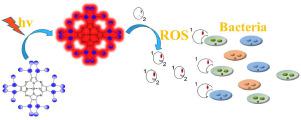Journal of Organometallic Chemistry ( IF 2.3 ) Pub Date : 2020-12-29 , DOI: 10.1016/j.jorganchem.2020.121669 Magdalena Stolarska , Arleta Glowacka-Sobotta , Daniel Ziental , Jolanta Dlugaszewska , Michal Falkowski , Jadwiga Mielcarek , Tomasz Goslinski , Lukasz Sobotta

|
Porphyrazine macrocycles with bulky peripheral phenylalkylsulfanyl substituents were subjected to photochemical studies. The singlet oxygen generation potential of these macrocycles was assessed using an indirect method with DPBF and all molecules revealed low singlet oxygen generation with quantum yields up to 0.03. In the photostability study, porphyrazine derivatives underwent photobleaching processes under light irradiation with quantum yields up to 2.45 ∙ 10−5. The photocytotoxicities of sulfanyl porphyrazine derivatives were researched in liposomal nanoparticles against wound bacteria, such as Staphylococcus aureus, methicillin-resistant Staphylococcus aureus (MRSA), Staphylococcus epidermidis, and Streptococcus pyogenes. The most active macrocycles appeared magnesium(II) porphyrazines with 5-(3,5-dibutoxycarbonylphenoxy)pentylthio- and 2-[2-(3,5-dibutoxycarbonylphenoxy)ethoxy]ethylthio-substitents. According to calculated photokilling rates obtained in the photoinactivation study, the greatest reduction of bacterial growth up to 4.7 log was noted for S. pyogenes, whereas moderate activity 2.5–2.6 log was observed against S. aureus. Low or no photocytotoxicity of studied macrocycles was noted against MRSA and S. epidermidis.
中文翻译:

具有庞大外围取代基的硫烷基卟啉对伤口细菌的光化学性质和光细胞毒性
对具有庞大外围苯基烷基硫烷基取代基的卟啉大环化合物进行了光化学研究。使用DPBF间接方法评估了这些大环的单线态氧生成潜力,所有分子均显示出低的单线态氧生成,量子产率高达0.03。在光稳定性研究中,卟啉衍生物在光照射下经历了光漂白过程,其量子产率高达2.45∙10 -5。研究了硫烷基卟啉衍生物在脂质体纳米颗粒中对创面细菌如金黄色葡萄球菌,耐甲氧西林金黄色葡萄球菌(MRSA),表皮葡萄球菌和化脓性链球菌。活性最高的大环化合物是具有5-(3,5-二丁氧基羰基苯氧基)戊硫基和2- [2-(3,5-二丁氧基羰基苯氧基)乙氧基]乙硫基取代基的卟啉镁(II)。根据在光灭活研究中获得的计算的光杀死率,发现化脓性链球菌细菌生长最大减少至4.7 log ,而对金黄色葡萄球菌的中等活性为2.5–2.6 log 。对MRSA和表皮葡萄球菌的研究的大环化合物的光毒性较低或没有。



























 京公网安备 11010802027423号
京公网安备 11010802027423号